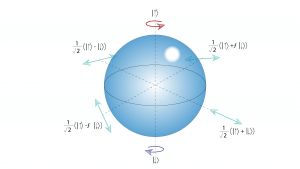Summary
As monolayers, transition metal dichalcogenides (TMDCs) – such as tungsten diselenide (WSe2) – become direct-bandgap semiconductors capable of emitting light. Compared to conventional direct-bandgap semiconductors, such as III-V semiconductors like GaAs, excitons (quasiparticles made of an electron hole bound with an electron) and single-layer TMDCs (SL-TMDCs) have much stronger binding energy. Excitons and SL-TMDCS also have an extra degree of freedom called “k-valley index” or “pseudospin”, which couples with their spin in the presence of light. Due to the way the spin and valley degrees of freedom couple together, excitons in SL-TMDCs can act as a two-level quantum system, whose quantum state can be initialized and controlled with photons of specific polarization, either collectively or as individual excitons confined in quantum dots. To utilize these two-level quantum systems as solid-state qubits in a quantum device, the spectral and temporal dynamics of SL-TMDC excitons in the presence of electric and optical fields needs to be investigated. However, some of the exciton processes in SL-TMDCs happen at timescales that are beyond the resolution of streak cameras used for studies of excitons in conventional semiconductors. To overcome this problem, this research will use femtosecond photoluminescence up-conversion (fsPLupC). This technique relies on sum frequency generation that arises when the photoluminescence signal overlaps with a reference femtosecond (fs) pulse inside a non-linear crystal. It can reveal both temporal and spectral information about the studied processes, potentially with a resolution better than 100 fs. This work will provide a greater fundamental understanding of TMDC monolayers and explore their potential use as ‘valleytronic’ based quantum devices.

Figure 1. Bloch sphere depiction of the optical addressability of bright excitons in a Single-Layer TMDC. Bright excitons with pseudospin ├ |↑⟩ or ├ |↓⟩ are created (annihilated) via absorption (emission) of a right-handed or a left-handed circularly polarized photon (red and blue arrows, respectively). The equator corresponds to equal superpositions of bright excitons in the two valleys and are therefore generated by absorption of linearly polarized photons denoted by green arrows.
Related Content

Spin Generation and High-Frequency Detection via the Quantum Nonlinear Anomalous Hall Effect in Weyl Semimetals
In magnetic conductors, the passage of current yields an electric field in the transverse direction even without an external magnetic field – this is known as the anomalous Hall effect (AHE). This effect can act as a convenient probe of spin ordering, magnetic textures, spin-orbit coupling, and band topology in solids, and can be further […]
April 19, 2023

Repurposing potential drug candidates for the treatment of COVID-19
Summary The main protease (Mpro) in severe acute respiratory syndrome coronavirus 2 (SARS-CoV-2), the virus responsible for the coronavirus disease (COVID-19), has emerged as a promising drug target. The scientific community has produced a large number of crystallographic structures of the protease, which mediates viral replication and transcription. These structures report several fragments with varied chemotypes […]
May 6, 2020

Quantum Sensing with Small Quantum Systems
Summary There are small quantum systems over which we have very good control and which have long lifetimes. Examples include the phosphorous (P) defect in silicon (Si) and the nitrogen vacancy (NV) defect in diamond. With P defect in Si, we focus on improving our understanding of the hyperpolarization mechanism to better enable engineering of […]
December 1, 2016

Developing Tools for Quantum Characterization and Validation
Summary Coherence is essential for quantum computation; yet it introduces a unique sensitivity to any imperfections in hardware design, control systems, and the operating environment. Overcoming these sensitivities requires a hierarchy of strategies, ranging from optimization of the hardware architecture to software solutions including quantum error correction. Randomized Benchmarking Protocols are an important family of […]
October 3, 2017

